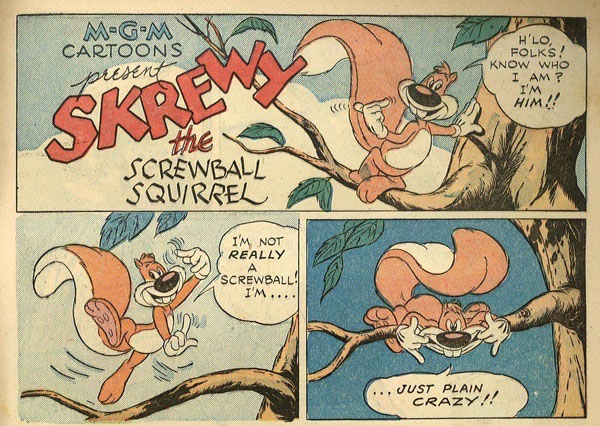
“On April 1, 1944, [Tex] Avery unleashed an April Fool’s joke on the world. In the short Screwball Squirrel, he introduced Screwy Squirrel, who was two degrees of separation on the insanity scale from Daffy Duck, another of Avery’s ‘discoveries’ when he was at Warners.” – John Canemaker, in his book Tex Avery: The Great American Director from the Golden Age of the Hollywood Cartoon.
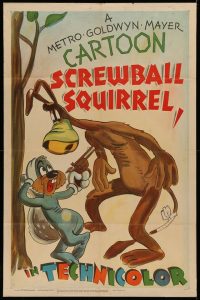 MGM’s Screwball Squirrel, celebrating its 80th anniversary this year, does indeed dial-up the “insanity” to 11 and stands as another brilliant notch in director Tex Avery’s legendary, over-the-top animation career.
MGM’s Screwball Squirrel, celebrating its 80th anniversary this year, does indeed dial-up the “insanity” to 11 and stands as another brilliant notch in director Tex Avery’s legendary, over-the-top animation career.
Screwball Squirrel announces itself in the opening moments of the short subject, taking a comedic swing at the milder Disney short subjects, as a cute, Disney-esque character named Sammy Squirrel skips across the screen, collecting nuts, and tossing them in a basket.
As he is about to pick up one of the nuts, Screwy Squirrel appears, asking, “Hey, what kind of cartoon is this going to be anyway?” “Well, you see, I play the lead in this picture,” Sammy answers timidly, with a smile on his face. “My name is Sammy Squirrel, and the story is all about me and my cute little furry friends in the forest.” Screwy rolls his eyes, exclaiming, “Oh brother! Not that!”
As Sammy continues to drone on, Screwy walks his fellow squirrel behind a tree and proceeds to pummel the cute little critter (we only see stars and hear the clamor, making it funnier). Screwy then tells the audience, “You wouldn’t like that story, anyway.”
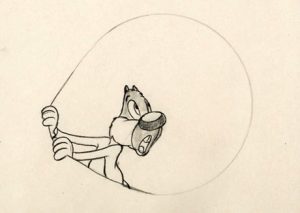 The story that does play out in Screwball Squirrel is one in which the titular character tortures a poor dog named Meathead. What follows is almost a “best of” Avery’s classic cartoon comedy gags.
The story that does play out in Screwball Squirrel is one in which the titular character tortures a poor dog named Meathead. What follows is almost a “best of” Avery’s classic cartoon comedy gags.
When Screwy smacks Meathead in the face with fly paper, the dog’s face peels off on the paper, leaving a white, blank slate where the dog’s features once were. When Screwy looks at the paper, multiples of the squirrel’s head pop out of his body in surprise.
Screwball Squirrel also plays with the fact that it knows it’s a cartoon. When planning his next cruel prank on Meathead, Screwy pulls back the corner of the screen to see what happens in the next scene. And, in another moment, as the film’s soundtrack skips, Screwy and Meathead’s movements repeat until the squirrel jogs the needle on the record.
As the short culminates, the audience learns that Screwy and Meathead were twins, which is how they accomplished all they did. Sammy Squirrel returns and tells the audience, “My cartoon would’ve been cuter!” After this, Screwy and Meathead beat the cuter squirrel as the short ends.
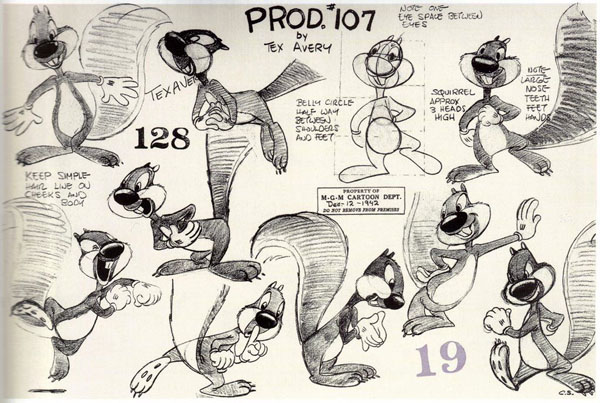
In addition to the brilliance of Avery at the helm as director, Screwball Squirrel features inspired work from his legendary collaborators, including animators Ed Love and Preston Blair and storyman Heck Allen.
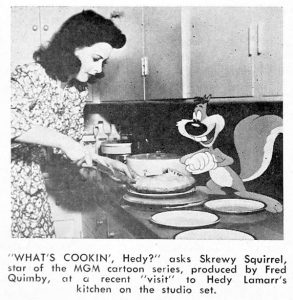 The team played with the rules by not only breaking every “wall” in Screwball Squirrel, but also in staging. In one scene, Screwy and Meathead jump into a barrel that starts rolling, and the camera seems to “follow” the barrel from above as it rolls past, then down a hill. It’s a dizzying moment in an already dizzying film.
The team played with the rules by not only breaking every “wall” in Screwball Squirrel, but also in staging. In one scene, Screwy and Meathead jump into a barrel that starts rolling, and the camera seems to “follow” the barrel from above as it rolls past, then down a hill. It’s a dizzying moment in an already dizzying film.
Adding to the freewheeling proceedings is great voice work by actors Wally Maher, as Screwy and Cal Howard as Meathead.
After this debut, Avery would bring Screwy Squirrel back in the shorts Happy-Go-Nutty, Big Heel-Watha (Buck of the Month), The Screwy Truant, and Lonesome Lenny. Screwy never caught on like many other characters of this classic age. However, eighty years after Screwy’s debut, many animation fans still consider the riotous little rodent an ingenious creation from one of the legends of the art form.
In his book, Of Mice and Magic: A History of American Animated Cartoons, Leonard Maltin summed Screwy up best: “…Avery took his character further and made him so aggressive, so completely obnoxious that there was no room left for ‘lovability.’ Screwy died after four films, but not without leaving some pleasant memories behind. It’s hard to completely dislike a character who can lead a pursuing dog into a darkened cave – where all light is cut off, even to us – and after an enormous crash light a match and say, ‘Sure was a funny gag – too bad you couldn’t see it!’”
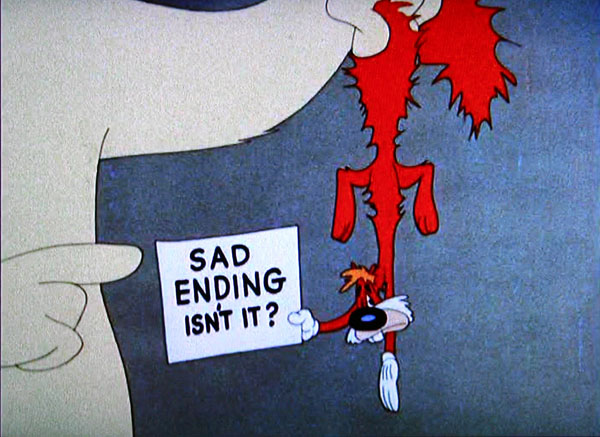
From Screwy’s last appearance – at the conclusion of “Lonesome Lenny”


 Michael Lyons is a freelance writer, specializing in film, television, and pop culture. He is the author of the book, Drawn to Greatness: Disney’s Animation Renaissance, which chronicles the amazing growth at the Disney animation studio in the 1990s. In addition to Animation Scoop and Cartoon Research, he has contributed to Remind Magazine, Cinefantastique, Animation World Network and Disney Magazine. He also writes a blog, Screen Saver: A Retro Review of TV Shows and Movies of Yesteryear and his interviews with a number of animation legends have been featured in several volumes of the books, Walt’s People. You can visit Michael’s web site Words From Lyons at:
Michael Lyons is a freelance writer, specializing in film, television, and pop culture. He is the author of the book, Drawn to Greatness: Disney’s Animation Renaissance, which chronicles the amazing growth at the Disney animation studio in the 1990s. In addition to Animation Scoop and Cartoon Research, he has contributed to Remind Magazine, Cinefantastique, Animation World Network and Disney Magazine. He also writes a blog, Screen Saver: A Retro Review of TV Shows and Movies of Yesteryear and his interviews with a number of animation legends have been featured in several volumes of the books, Walt’s People. You can visit Michael’s web site Words From Lyons at: 






















This and the other four cartoons are, indeed Avery outdoing himself. This was to the point where I’ve heard that text didn’t even like the character himself, nor did he ever wanna hear about praise of the character from fans of his work! I guess he did his job better than he had anticipated! Tex apparently was also never a fan of repeating cartoon characters. I guess he would have rather been fonder of one shot cartoons instead of creating characters of lasting appeal. So I guess this is right up his alley.
Years ago my brother and his wife went on a trip and left their dogs with my parents while they were away. Our own family dog had passed away some years earlier, and the local squirrels had had the run of the backyard and its big oak tree in the meantime. When the dogs ran out into the yard, the squirrels scurried up into the trees and gave out an alarm call that, I swear, sounded exactly like Screwy Squirrel’s laughter. You didn’t think you were watching a nature documentary? Think again!
Interesting to see that photo of Screwy with Hedy Lamarr (and I bet I know what Screwy’s planning to do with that pie). In Tex Avery’s “A Wild Hare” of 1940, Bugs covers Elmer’s eyes and asks “Guess who?” Elmer guesses “Hedy Wamarr?” Tex must have had a thing for her, and who could blame him? Of course, another screwball cartoon character introduced in 1940 and voiced by Mel Blanc would become much more famous for saying “Guess who?”, but Avery had nothing to do with that.
Screwy would later be the inspiration for the Animaniacs character Slappy the Slap-Happy Squirrel, a former cartoon star now well past her prime (like her aging comic foils Walter Wolf, Sid the Squid, and Beanie the Cerebrally-Challenged Bison). But she could still throw a bomb with the best of them. Now that’s comedy!
Unfortunately Avery formed an intense dislike for the Screwy character and killed him off just as his series was getting underway. Sad, isn’t it?
I’ve always thought that Avery never much liked “screwball” or more proactive characters in his films. Given his disdain for Screwy (throwing fan letters of him in the trash) and how few films he actually made with Daffy and Bugs (three and four, respectively), plus his dismissal of “A Wild Hare” years later, it’s possible that character archetype didn’t gel with his sense of humor and approach to direction.
Not to dismiss these films, of course, but looking over Avery’s filmography as a whole, his best works usually involved bad puns, low-key or passive characters, and sight gags – things a “screwball” doesn’t necessarily do well or would so in such a way to draw the joke towards themselves.
Which is why I always thought of Screwy Squirrel as Avery trying to deconstruct the very mold he forged by showing how obnoxious and one-dimensional they truly were, but whether through executives or audiences not getting the idea he angrily threw the character out after only a few shorts, this time without a Jones or Clamped to refine him.
It has always seemed likely to me that Screwy Squirrel was intended from the start as Tex’s viciously sarcastic way to shut up MGM front office demands to create “another Bugs Bunny”. The character was designed to fail and it did. Tex’s Droopy was at least allowed to develop organically.
Given that Avery walked out on Schlesinger after the two disputed over the ending to a Bugs Bunny cartoon, I can believe that entirely. Having the freedom to create his own characters as he saw fit and being pestered by higher-ups to just make more screwballs must’ve made him bitter.
“Big Heel-Watha” in particular always came across to me as taking the piss out of “Hiawatha’s Rabbit Hunt” and his former colleagues and creations over on Warner’s lot. Watching the two side by side, I got the feeling Clampett wasn’t the only one who didn’t think highly of Freleng’s attempted Oscar win.
“Another Bugs Bunny” was undoubtedly MGM’s primary motivation behind hiring Tex in the first place. Witness the gradual diminishing of the prominence of his name on the (hideous) posters as it became clear that he wasn’t going to deliver. Given Tex’s state of mind at his absolute peak, I can only imagine where he was emotionally by the time Hanna-Barbera was placing an order for Kwicky Koala!
And speaking of Freleng, isn’t it ironic that his time at MGM was the precise opposite of Avery’s, signing on in anticipation of creating a new star character (“another Porky Pig!”) only to be handed The Captain and the Kids.
Diminishing my foot. I thought his output at MGM was quite good throughout his time (Yes, I like the “Of Tomorrow” series).
SCREWBALL SQUIRREL is my favorite Screwy Squirrel cartoon. It’s so funny and shows Tex Avery at his best. The part where Screwy has multiple heads when he sees Meathead’s face on the flypaper inspired a similar scene in the Minerva Mink cartoon “Meet Minerva” on ANIMANIACS.
Screwy Squirrel is my absolute favorite of Tex’s characters and so under appreciated. I’ll argue that the cartoons which stared him had the most gags per second and the most manic paced of the theatrical cartoons of the Golden Age. Animated shorts with this type of humor that defined what cartoons were, and paced at such a frenzied level wouldn’t been seen again until the Roger Rabbit shorts of the early 90s. With those Screwy shorts, like those Roger Rabbit shorts, we were only given a scant handful. And again, like those Roger Rabbit shorts, perhaps that’s part of what makes them so special.
Also, what is that comic image at the top of the article, and where can I find one?
That image is from Dell Comics’ Our Gang Comics #12 (July-August 1944). “Skrewy”, as Dell inexplicably spelled his name, also appeared in the back pages of issues #13 and #14, but he would not be seen in comic books again until Dark Horse revived the character fifty years later.
The Los Angeles Times of March 17, 1944 reveals this cartoon was appearing with A Guy Named Joe, starring Irene Dunne. at four area theatres. It was also on the bill on March 31, 1944 at the Broadway Theatre in Albert Lea, Minn. with the all-women feature Cry Havoc.(which sounds like a screwy pairing).
Screwy cartoons are laden with some great gags. The barrel gag is wonderful, and the POV animation must have been a bear to work out.
Some time ago I worked as a direct sales agent for Time Warner cable. One April 1st morning while I was in the office before hitting the road in quest of customers we began to get some odd phone call. It seems the same Screwy Squirrel cartoon was playing over and over and over on someone may have hacked the channel. However after a few phone calls to TWC it turned out that someone at Cartoon Network thought it would be a great “April Fool “ trick. I understand that person wound up seeking other employment later that day.
Great post, Mike! Screwy offering himself to Heel-Watha just to get him to stop crying mirrors Bugs’ reaction to Elmer’s whining in FRESH HARE and HARE-BRAINED HYPNOTIST. In LONESOME LENNY, rather than being the instigator Screwy finds himself getting dragged into the setup and meeting his match. It’s clear Screwy gradually shifted from Daffy/Culhane-era Woody Woodpecker on steroids to a Bugs Bunny-like figure, and understandably Avery figured he was going nowhere with Screwy despite demands for more. Nevertheless Screwy remains at his best when his actions end up messing with the natural order of things, going as far as making fun of cartoon conventions and tropes. He is the perfect character to make fun of his own audience.
Thank you! Glad you enjoyed it!
Wonderful post. Screwy rules!
Thank you, Tom! I’m glad you enjoyed it!
Screwy’s insane antics were funny, but his “head cold” voice and annoying laugh got old fast. I liked the canine characters Meathead and Lonesome Lenny though.